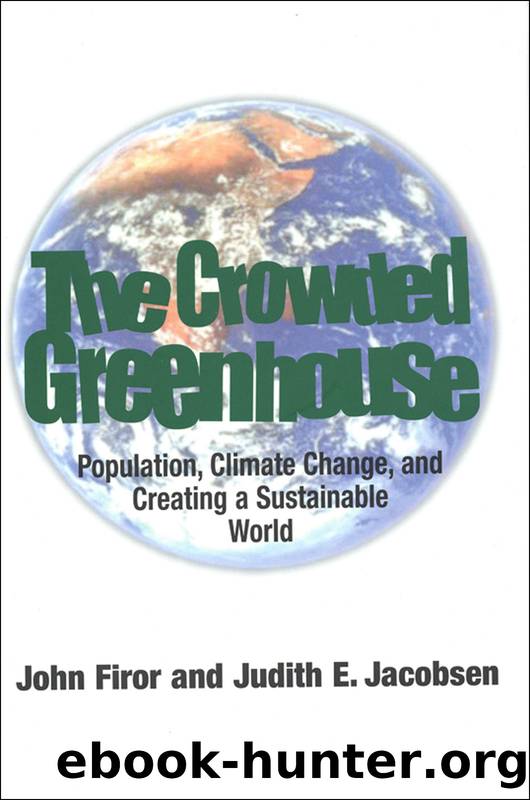The Crowded Greenhouse by John Firor & Judith Jacobsen

Author:John Firor & Judith Jacobsen
Language: eng
Format: epub
Publisher: Yale University Press
Published: 2002-07-14T16:00:00+00:00
International Scientific Reviews
In the 1980s, models achieved a high degree of sophistication, but they rather consistently showed a warming during the twentieth century about twice as large as that which the data experts deduced from the available temperature records. In 1990 the Intergovernmental Panel on Climate Change (IPCC), an international scientific group established by agencies of the United Nations, examined the data showing a rapid temperature rise, the progress in construction of climate models (including their over-estimation of the twentieth-century warming), and their use in estimating future change. The report issued by IPCC concluded that there was at least a possibility that human-caused emissions of gases that trap heat could warm the global climate to an extent that would be harmful. The adverse effects included damage to ecosystems influencing species diversity, loss of soil moisture during the growing season, damage to forests and agriculture, and a rise in sea level as warmer weather expanded sea water and melted glaciers.
IPCC conducted a second assessment of climate-change science in 1995. By that time the newly identified cooling influence of sulfates, along with ozone depletion in the atmosphere, had improved the realism of model calculations. Also, in 1991 a large eruption of the Pinatubo volcano in the Philippines allowed a direct test of the models. We know that sulfate particles shot into the atmosphere by major volcanic eruptions reach the stratosphere and remain in place for a year or two, rather than the week or two such particles stay in the lower atmosphere. The measured concentration of the stratospheric particles after Pinatubo could therefore be used to predict a cooling followed by a recovery a year or two later. One research group produced and published a prompt prediction of the magnitude of the global cooling that would occur and the schedule on which the temperature would return to its pre-eruption value. The reasonably close agreement of this forecast with what actually happened added one more step to the climb of model calculations toward respectability.
In 1995 IPCC best estimates of change, assuming a business-as-usual continuation of emissions, were a warming by the year 2100 in the range of 1 to 3.5 degrees Celsius, with a best guess of 2 degrees. Similarly, IPCC foresaw a 50-centimenter sea-level rise above the current level, reduction of the day-night temperature difference, greater warming of the land surface than the sea surface in winter, a maximum warming of high northern latitudes in winter, and an enhanced global mean hydrological cycle. In its overall summary, the 1995 IPCC report concluded that even though the committee recognized that uncertainties remained in key factors of the calculations, it felt that “the balance of evidence suggests that there is a discernible human influence on global warming.”
This conclusion, which went further than any previous statement, balanced the committee’s appreciation of the rapid scientific progress during the previous five years with its awareness of the work still needed on uncertain features of the model—specifically on the simulations of clouds and sea ice, and the role of water vapor.
Download
This site does not store any files on its server. We only index and link to content provided by other sites. Please contact the content providers to delete copyright contents if any and email us, we'll remove relevant links or contents immediately.
The Lonely City by Olivia Laing(4748)
Animal Frequency by Melissa Alvarez(4395)
All Creatures Great and Small by James Herriot(4232)
Walking by Henry David Thoreau(3893)
Exit West by Mohsin Hamid(3777)
Origin Story: A Big History of Everything by David Christian(3648)
COSMOS by Carl Sagan(3554)
How to Read Water: Clues and Patterns from Puddles to the Sea (Natural Navigation) by Tristan Gooley(3406)
Hedgerow by John Wright(3275)
The Inner Life of Animals by Peter Wohlleben(3259)
How to Read Nature by Tristan Gooley(3249)
How to Do Nothing by Jenny Odell(3232)
Project Animal Farm: An Accidental Journey into the Secret World of Farming and the Truth About Our Food by Sonia Faruqi(3177)
Origin Story by David Christian(3147)
Water by Ian Miller(3127)
A Forest Journey by John Perlin(3027)
The Plant Messiah by Carlos Magdalena(2883)
A Wilder Time by William E. Glassley(2818)
Forests: A Very Short Introduction by Jaboury Ghazoul(2790)
